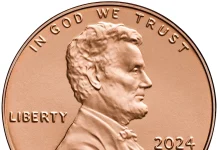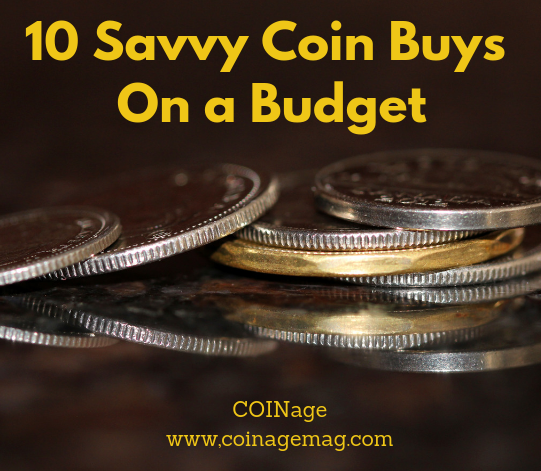
Editor’s Note: If you’ve ever found yourself fielding questions about how one goes about getting into coin collecting with a smaller budget, this list of 10 is a good bit of advice to share.
By Al Doyle
Here are 10 “home-run” coins in the $150 to $500 range.
Shield Nickel: An Overlooked Series
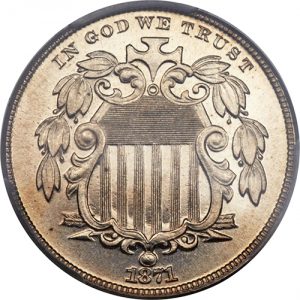
The nickel five-cent piece marked its 150th anniversary in 2016, and it retains the same alloy (75-percent copper, 25-percent nickel) and virtually the same dimensions it had in 1866. Shield nickels kicked off the long run of such coinage, and they were struck in a “with-rays” version (1866 and 1867) and “no-rays” version (mid-1867 to 1883). Collectors who want a type coin might consider one of the lower-mintage dates, rather than something common.
Just 561,000 pieces were struck in 1871, and though this is scarce, it is reasonably priced in Very Fine to About Uncirculated. The 1874 to 1876 Shield nickels are somewhat harder to find than the early issues, and they are well worth obtaining.
Oregon Trail Commemorative: Eye Candy
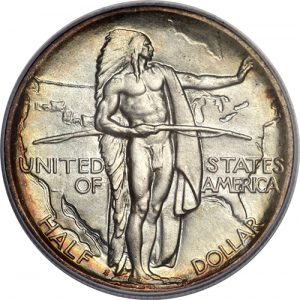
The Oregon Trail commemorative half dollar always makes the short list of America’s most beautiful coins. The pairing of a westward-bound family in a covered wagon along with a muscular Native American in flowing headdress is the kind of design that turns the formerly apathetic into coin collectors.
Struck from 1926 to 1939, the series includes common dates along with lower-mintage issues (as low as 3,004). “Commem” prices have been in a long-term slump, so it’s an excellent time to add this masterpiece to your collection.
$5 Indian Head Gold: American Classic

Sticking with the Native American theme, the $5 Indian gold piece of 1908 to 1929 is distinguished by its intricate incuse (impression/mark) design. It’s hard to beat this combination of artistic boldness and nearly a quarter-ounce of gold.
Common dates in Extremely Fine and AU would fit into the financial boundaries of this article, and those who obtain one or more $5 Indians don’t regret doing so.
Flying Eagles: 1857-Dated Cents
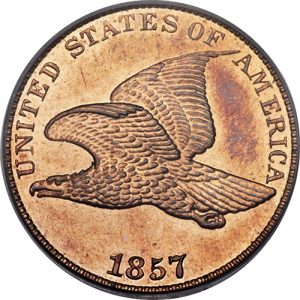
Both circulating cents from this year would make excellent additions to one’s holdings. The 1857 Flying Eagle is a perennially popular item, and EF to Mint State-61 examples will take a lower-budget collection to the next level.
Since it’s the last U.S. large cent, the 1857 Coronet cent is a quick seller, and its desirability is enhanced by a modest mintage of 333,546. Why not acquire both of these historic prizes if the funds are available?
Seated Liberty: Impressive Silver Dollar

Even beginners often own some Morgan or Peace dollars, and there is a simple way to leapfrog to a much higher level on the cartwheel scale. Fewer than 6.4 million Seated Liberty dollars were struck during the 33-year (1840 to 1873) lifespan of the series. Compare that with the date-and-mint-mark combinations in the Morgan and Peace series, which have annual mintages above the entire run of Seated dollars.
Surviving Seated dollars tend to be quite worn or damaged by abuse. That’s why it pays to stick with certified coins that have been evaluated by a reputable third-party grading service. Fine and VF are the grades to look for if money is an issue. Few hobbyists can say they have owned such a classic scarce coin, so this is a genuine prize.
2016 Gold Standing Liberty: Celebrate the Centennial

The U.S. Mint issued a quarter-ounce gold Standing Liberty quarter last year to mark the 100th anniversary of the series’ introduction. Why not go back in time for the real thing?
Hobbyists who can spend a few hundred dollars might consider certified Mint State-63 and MS-64 specimens of higher-mintage coins with this eye-catching design. If funds are limited, a problem-free piece in Extremely Fine or AU is a realistic option. Circulated “Standing” quarters of 1925 to 1930 are especially well suited for budget-minded shoppers.
$2 1/2 Liberty: A Golden Sleeper
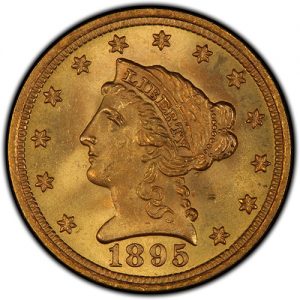
Due to the length of the series (from 1839 to 1907), very few collectors have the funds to pursue a complete set of $2½ Liberty gold pieces. Don’t let that prevent you from obtaining one or two of the many reasonably priced low-mintage dates in the series. Nineteenth-century U.S. gold coinage with mintages of less than 15,000 for $300 to $500? Here are some of the options:
Just 4,000 business-strike quarter eagles were produced in 1882, 1886 and 1894. That number rose to 6,160 in 1887 and 8,720 in 1890. Despite creeping into five figures (10,960) in 1891, that date still fits into the “something special” category. Check out the 1895 and its mintage of 6,000. The 1888, 1889 and 1896 all have mintages of less than 20,000, and they carry modest premiums above their more common counterparts.
Half Dollars: “Bust” Your Budget
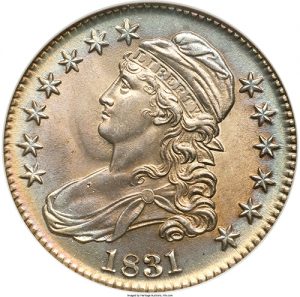
How about traveling two centuries into the past for that special coin? Bust half dollars in the EF to AU range are classic U.S. collector coins that won’t break the bank.
The series is known for its 400-plus varieties, but that isn’t a concern for the hobbyist who wants a single type coin.
Bust quarters of 1831 to 1838 are another old-time option for those who seek to step beyond the mundane.
Semi-Keys: One Step Forward

In many instances, key dates such as the 1909-S VDB Lincoln cent, 1916-D “Mercury” dime and 1893-S Morgan dollar are well beyond the resources of mid-level collectors. If that is your situation, seek out some of the scarcer semi-keys in various series.
Coins such as the 1867 and 1908-S Indian Head cents, 1917-S and 1918-D Buffalo nickels, 1925-D and 1926-S Mercury dimes, 1898-O and 1905-S Barber quarters, along with the 1916 and 1928-S Walking Liberty half dollars, are elusive in VF or better. These and other tougher dates will be quick sellers when it’s time to dispose of your collection.
$5 ‘Woodchopper’: Highlight of ‘Horse Blankets’

U.S. paper money was much larger prior to 1928, which explains why these old notes are sometimes referred to as “horse blankets.” In addition to their size, notes from that era were full of intricately designed and engraved examples of monetary artwork.
Some of the better values include the $5 “Woodchopper” United States Note of 1875 to 1907 and the $5 National Bank Note of the early 1900s with the compelling portrait of the Pilgrims on the back. Early large-size Federal Reserve Notes can be had for reasonable prices.
This is just a sampling of the kind of special items that can make a collection better. Look around, and you will come up with your own list of reasonably priced coins that go well beyond ordinary.



